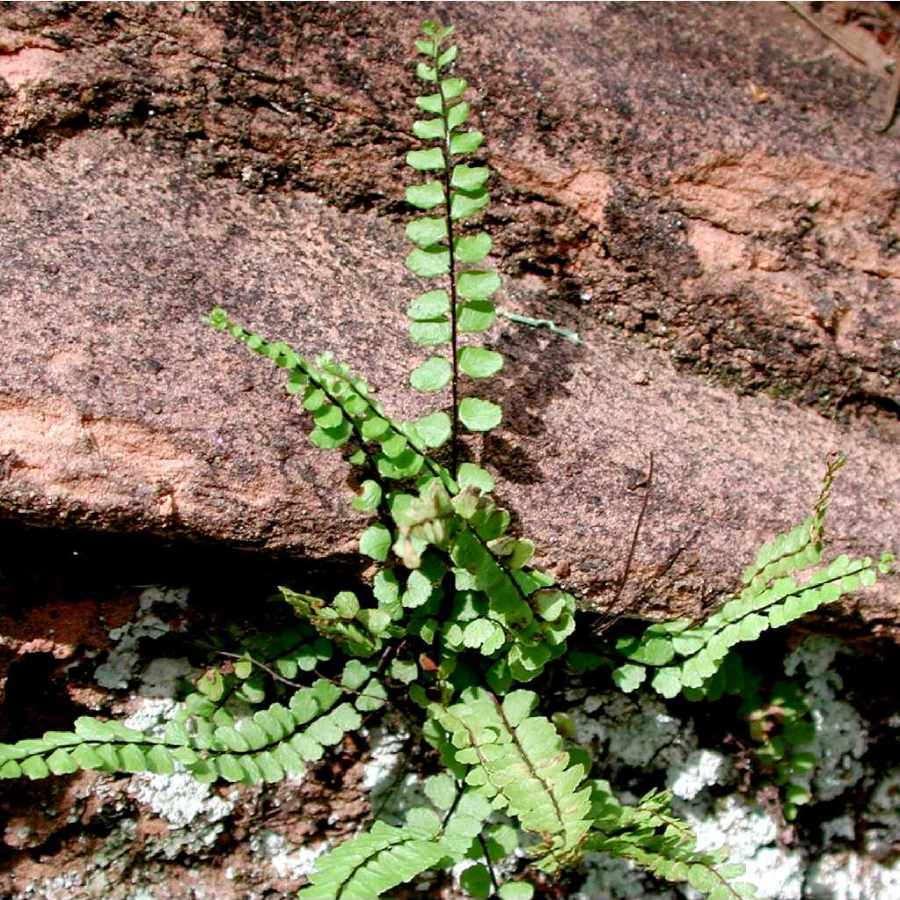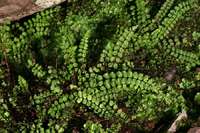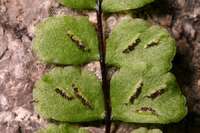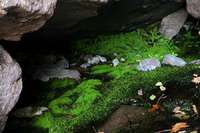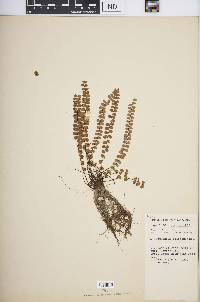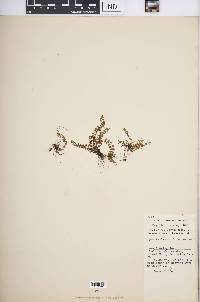|
|
|
|
Family: Aspleniaceae
dense spleenwort, more...maidenhair spleenwort
|
General: Short creeping stems, often branched from short rhizomes, with many fronds, in dense or radiating tufts. Leaves: Monomorphic, with reddish brown or blackish brown petiole, lustrous, 1-4 cm long; blade linear, once pinnate, 3-22 cm long by 0.5-1.5 cm wide, thin, glabrous to sparsely pubescent; base gradually tapers; rachis reddish brown; pinnae in 15-35 pairs, oblong to oval, often oblong and broadly wedge-shaped at base and somewhat expanded at upper margin, but not auriculate, entire, crenate to slightly incised; stipe firm, threadlike and shiny purplish-brown. Sporangia: Sori in 2-4 pairs per pinna, on both sides, spores 64 per sporangia. Ecology: Found on acidic substrates like sandstone, basalt and granite, often in the shade, in crevices and along cliffs from 6,000-9,000 ft (1829-2743 m). Notes: FNA indicates that our species is ssp. trichomanes. Ethnobotany: Taken for coughs, for liver complaints, and for irregular menstruation. Etymology: Asplenium is from Greek a, without and spleen, while trichomanes is the name of a fern as mentioned by Theophrastus and Dioscorides, for a fern resembling Adiantum. Sources: FNA 1993, Dittmer 1954, Yarborough and Powell 2002, Kearney and Peebles 1969 Rhizome 1.5-2 mm thick, the lanceolate brown scales 1.5-2 mm; lvs numerous, 5-25 cm, the purple-brown petiole to 6 cm; blades uniform, linear, pinnate throughout, to 19 נ1.7 cm, acute to attenuate above, usually not narrowed below, thin, dark green, the thin, flexible rachis almost wholly dark; pinnae 9-20 pairs, mostly opposite, oval to round oblong, oblique with the upper side the larger, but not auriculate, 4-8 נ3-6 mm, mostly crenate, subsessile; 2n=72, 144. On shaded, mostly calcareous rocks; interruptedly circumboreal, and nearly throughout our range, s. to Ga. and Tex. Gleason, Henry A. & Cronquist, Arthur J. 1991. Manual of vascular plants of northeastern United States and adjacent Canada. lxxv + 910 pp. ©The New York Botanical Garden. All rights reserved. Used by permission. FNA 1993, Dittmer 1954, Yarborough and Powell 2002, Kearney and Peebles 1969 Common Name: maidenhair spleenwort Wetland Status: FAC Rarity: None General: Short creeping stems, often branched from short rhizomes, with many fronds, in dense or radiating tufts. Leaves: Monomorphic, with reddish brown or blackish brown petiole, lustrous, 1-4 cm long; blade linear, once pinnate, 3-22 cm long by 0.5-1.5 cm wide, thin, glabrous to sparsely pubescent; base gradually tapers; rachis reddish brown; pinnae in 15-35 pairs, oblong to oval, often oblong and broadly wedge-shaped at base and somewhat expanded at upper margin, but not auriculate, entire, crenate to slightly incised; stipe firm, threadlike and shiny purplish-brown. Sporangia: Sori in 2-4 pairs per pinna, on both sides, spores 64 per sporangia. Ecology: Found on acidic substrates like sandstone, basalt and granite, often in the shade, in crevices and along cliffs from 6,000-9,000 ft (1829-2743 m). Notes: FNA indicates that our species is ssp. trichomanes. Ethnobotany: Taken for coughs, for liver complaints, and for irregular menstruation. Etymology: Asplenium is from Greek a, without and spleen, while trichomanes is the name of a fern as mentioned by Theophrastus and Dioscorides, for a fern resembling Adiantum. Synonyms: None Editor: SBuckley, 2010 |


